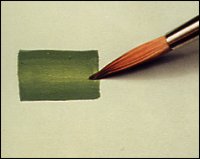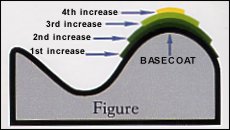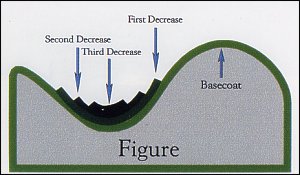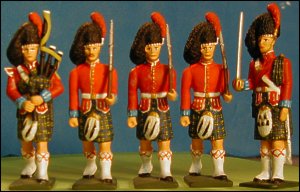Painting Metal Miniatures: Part 2 - Techniques
| STAGE#10 - Painting the figure Part 2 - techniques. |
|
We take a short break from painting the figure this week and concentrate on the techniques involved. Layering: The application of successive paint coats over the same area.
 Feathering: The application of progressively smaller transparent layers of colour in order to visually blend each layer into the previous one. This visual bleanding is achieved by slightly increasing or decreasing the brightness or darkness of each successive feather. Use: Shading and highlighting. Dilution rates of 1:5 +.
Highlighting and Shading: Combine the layering and feathering techniques. Highlighting is accomplished by adding a small amount of a higher value colur to our base colour, thinning it accordingly (1:5+) and starting with the widest feather that corresponds to the lowest point of the area to be highlighted, carefully apply this first increasae layering it as required to obtain the desired intensity. Next, add another small amount of highlighting colour to your last mixture and apply the next feather on a smaller area again by layering it as necessary. Repeat this process until all your increases have been applied. Shading: Normally you shade areas where light gathers the least or requires a little help in defining their form and it is normally done once our highlights have been applies. Similiar to the highlighting process except you use darker colours to create the desired effect. Use higher dilution rates (1:8+) and ususally up to 3 colour decreases. If you only use a thick dark coat you may obscure some painting details. Before applying this diluted paint unload your brush on a clothe several times. References: Mario Fuentes tutorial in 'Historical Miniature' Sept/Oct.
SUBSCRIBER HINTS AND TIPS: Painting Tartans
John O'Brien's website has some fine info on this interesting subject. http://www.angelfire.com/tx/ToySoldier/tartan.htm (Thanks for bringing it to my attention, Judge Jack Smith - subscriber.)
|




